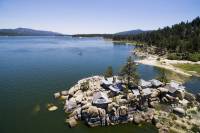Arapahoe Basin Via Ferrata Is North America’s Highest: We Climbed It & You Should Too
Arapahoe Basin’s via ferrata is the ultimate high alpine adventure. This week, we strapped on harnesses and helmets to experience it for ourselves.
A group of eight of us stood, sipping coffee, in the early morning shadow of the East Wall at Arapahoe Basin. In a few minutes, we’d hike over a small scree field up to the base of the rock and ascend 1,200 feet to the summit.
Typically, I was used to gazing over at steep chutes blasted in snow — now, I was looking at the wall with a whole new perspective. It took about 5 seconds for me to go from clipping into the cable to cracking a smile.
Via ferrata, Italian for “iron path,” is a stellar way to explore rocky, sometimes vertical terrain — without needing extensive climbing or mountaineering experience. Via ferratas have existed since their invention during WWI in Europe, but are newer concepts here in the U.S.
Arapahoe Basin Via Ferrata: Open Now

A via ferrata is essentially a protected climbing course. They use a combination of steel cables, rungs, ladders, and even bridges fixed to the rock. Climbers clip to these while scaling the course. They wear a harness and are protected by a simple set of purpose-built carabiners and lanyards. It’s much easier to learn than traditional rock climbing, requiring just minutes of education versus days.
Via ferratas vary in terrain, from fourth- and fifth-class scrambling to sheer vertical ascents up iron, ladder-like rungs. Some routes are more vertical overall, while some courses are traverses across a mountain face. Some are shorter, while some have a steeper objective, like a summit. Many via ferratas in Europe (like those in the Dolomites) can even be linked together for higher alpine adventures.

Two of us at GearJunkie recently got the chance to experience the via ferrata with two core alpine brands — Salewa and Dynafit. The day included climbing the route, and testing out new gear built for mountain and alpine environments.
Here’s all you need to know about the newest via ferrata at Arapahoe Basin.
A Basin’s East Wall Via Ferrata
- Base elevation: 11,500 ft.
- Vertical gain: 800-1,200 ft.
- Via Ferrata summit elevation: 12,998 ft.
- Route info: 0.5-mile hike to A Basin’s East Wall
- Route options: Half- or full-day routes; notable points on the route include a mine shaft and summit
- Time commitment: Approx. 3-6 hrs.
- Price point: $155-250/person
Why Visit the Via Ferrata at Arapahoe Basin

Well, for one, this via ferrata route is really fun.
The terrain is gorgeous, traversing solid granite above sweeping views. The route has lots of added rungs for climbing ease, but also has a lot of natural climbing available. There are several sections of scrambling, quite a few steep slabs, ledges, and a few vertical ladder sections. Don’t be fooled by other via ferrata routes that simply traverse a rock face — this one is mostly vertical.

I went with a group of people who have done many other via ferratas — and they all agreed this one’s route was well-designed. Bonus: there’s a slightly different route on the descent for a change of scenery.
And of course, nothing beats the feeling of climbing the highest via ferrata in the nation (in terms of overall elevation). Jackson Hole’s longest via ferrata route ascends 500 vertical feet, Ouray’s main via ferrata route gains about 400 vertical feet, and Telluride’s via ferrata gains about 600 vertical feet. Even these other via ferratas in Colorado and across the West only have a base of 8,000-9,000 feet.

Arapahoe Basin’s high-elevation via ferrata even beats out some of the longer ones in Canada, topping out at 12,998 feet. Banff’s Mt. Norquay boasts the longest via ferrata route at 465m (about 1,500 feet of elevation), but it only starts at about 8,000 feet.
There are more than 20 via ferratas in North America today — from Zion National Park to the Rocky Mountains to California to Canada.
But if a big mountain and high-summit adventure with 360-degree views are what you’re looking for, A Basin’s is the one to beat.

What to Bring on a Via Ferrata
Even if you’re a beginner at climbing, a via ferrata is a great way to actively enjoy a mountain. It helps if you have some basic climbing knowledge or experience traveling in higher alpine places, and it also helps if you aren’t phased by heights!
If you are new to the via ferrata experience, here’s some key gear we recommend bringing along:
- Stretchy clothes and layers
- Closed-toed, lightweight footwear (our group was kitted out with some new Salewa approach shoes)
- Sunglasses
- A lightweight pack with sternum and hip straps (make sure it fits securely to your body)
- Hydration bladder (key for when you may not have hands to reach for a water bottle)
- A camera for the top

Professionally guided via ferratas tend to provide all the necessary climbing and safety equipment. At Arapahoe Basin, the trip outing includes a helmet, harness, carabiners, and lanyard system. Arapahoe Basin requires climbers to have a guide for the excursion, which costs $155-250 per person.
The experience includes a scenic lift ride to mid-mountain, an OHV ride to the bottom of the route, an introductory lesson by Arapahoe Basin’s staff guides on a “mini ferrata” course, and a gourmet charcuterie lunch for full-day summit climbers.
2022 is the second season of this via ferrata (which first opened in late June 2021). The via ferrata is open 7 days a week, June through September 5, 2022.
The post Arapahoe Basin Via Ferrata Is North America’s Highest: We Climbed It & You Should Too appeared first on GearJunkie.


